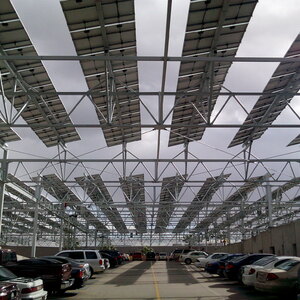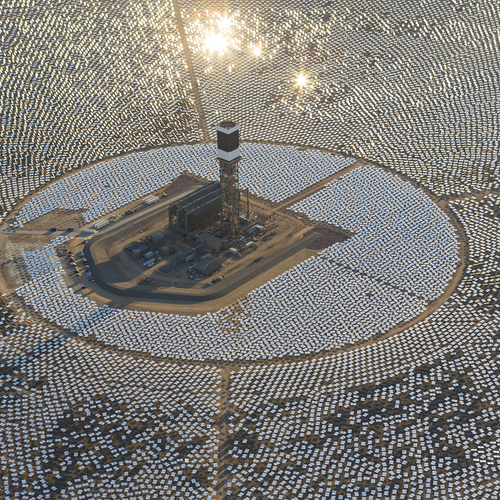
A California-based startup says it has developed a new type of concentrating solar technology that can produce temperatures high enough to replace fossil fuels in industries that so far haven’t been able to make a dent in their carbon emissions.
The company, Heliogen, built a demonstration array in Lancaster, California, showing off the technology and only recently made it public. Heliogen backers include Bill Gates and other well known entrepreneurs.
Like other concentrated solar power (CSP) systems, this one uses a number of mirrors that can be controlled individually to focus solar energy in a small area. Where it differs from existing CSP technology is how precisely the heliostats (moveable mirrors) can be adjusted and kept in alignment, resulting in temperatures of 1,000°C (1,832°F) at the point where the sunlight concentrates. The company says temperatures of 1,500°C are possible.
That makes the Heliogen model a potential breakthrough for industries like cement- and steel-making, which use huge amounts of high-temperature energy. Existing solar arrays have not been able to create temperatures that would allow these kinds of production facilities to wean themselves off of fossil fuels.
The announcement on Nov. 19 generated a number of news articles, the most detailed of which so far seems to be a post by David Roberts on the website Vox. He writes that while renewable energy can now replace carbon-emitting fossil fuels in electricity, buildings and transportation, industrial sectors of the economy haven’t been able to find low-carbon sources of energy that meet their needs.
Collectively, these industries produce 20% of global carbon emissions, so Heliogen’s announcement could be a very big deal.
One of the best known CSP installations now in service is the $2.2 billion Ivanpah solar power plant, which opened in 2014 in the Mojave Desert on the California-Nevada state line. Its 173,500 heliostats concentrate sunlight on boilers that are mounted on three centrally located towers. The plant, which also burns natural gas, has a capacity of 392 megawatts of electricity. After some initial setbacks, Ivanpah was meeting its contracted power output by 2017.
There are a few differences with the Heliogen project. One is that the mirrors are smaller and less complicated. More important is that their orientation is monitored and adjusted in real time, keeping the concentrated solar energy in a very small, tightly controlled space. As a result, temperatures are much higher than what could be produced in CSP stations to date.
The mirrors are controlled by computer software linked to cameras on the concentrating tower. The software monitors the orientation of all of the mirrors and makes whatever adjustments are necessary to keep sunlight focused on a spot about 20 inches across.
The company’s CEO, Bill Gross, used a similar approach in an earlier venture called eSolar. He told Roberts that the Heliogen system takes huge amounts of computing power to work, capabilities that weren’t available just five years ago.
Among the industrial processes that could use 1,500°C heat is the generation of liquid fuels that could take the place of hydrocarbons, Roberts writes. This “synfuel,” a mix of hydrogen and carbon monoxide, could be refined into “any fuel, for any purpose.” If the C02 used in the process is taken from ambient air, the fuels would be considered carbon neutral.
At its website, Heliogen says its technology can be used to split water to create “100% green hydrogen.”
While the technology is promising, Gross says there are many unknowns, and no way of accurately predicting either costs or real-world performance. The company says it is looking for both customers and partners (see the video link above) to move the technology ahead.
-Scott Gibson is a contributing writer at Green Building Advisor and Fine Homebuilding magazine.
Weekly Newsletter
Get building science and energy efficiency advice, plus special offers, in your inbox.















6 Comments
Does this mean I can use it to forge Thor's hammer? ;)
BOTH WIND TURBINES (WHICH ARE SOMEWHAT SENSELESS) AND HELIOSTATS ARE
DANGEROUS TO ANIMALS AND HUMANS..
The article never mentions wind turbines, so you didn't read it.
Good grief.
The Dutch expression "Hij heeft een slag van de wiek gehad", alternatively, "Hij heeft een klap van de molen gekregen" (same meaning, different words) may be appropriate here. :-)
Google translate: "He has received a blow from the mill." Help us out, Dana.
Log in or create an account to post a comment.
Sign up Log in